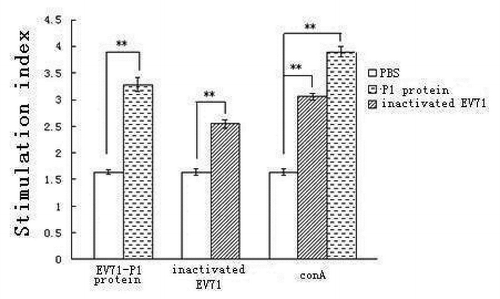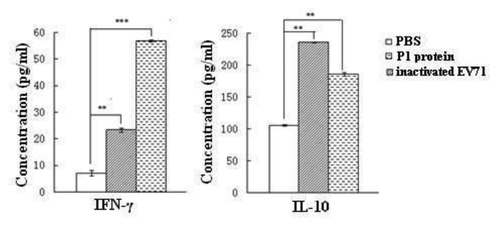Figures & data
Figure 1. The identify of the EV71-P1 protein. (A) The SDS-PAGE analysis of P1 protein. The concentration of separatin gel was 10% for SDS-PAGE. M, market; 1, the purified P1 protein. (B) western blot analysis of P1 protein. The concentration of separating gel was 10% for western blot. 1, the purified P1 protein; 2, the pPIC9k-GS115 supernatant.
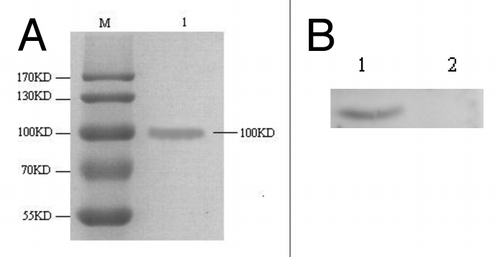
Figure 2. The mean of anti-EV71 antibody titers. Serum samples were collected on the days indicated on the x-axis. Group (2 μg P1 protein) was immunized with 2 µgP1 protein; group (20 μg P1 protein) was immunized with 20 µg P1 protein; group (2 μg inactivated) was immunized with 2 µg. Heat-inactivated EV71; group (20 μg inactivated) was immunized with 20 µg. Heat- inactivated EV71 alone respectively on day 0 and day 14 and day 28 (indicated by *)
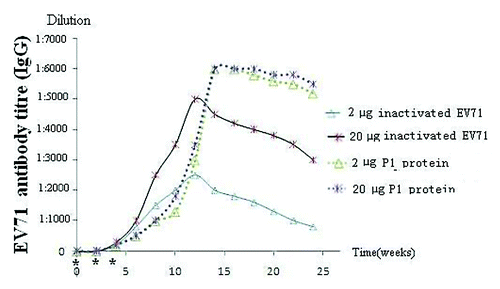
Figure 3. The neutralizing ability assay of anti-EV71 antibody in vitro. The sera were collected from the immunized rabbits at different time points were serially diluted, mixed with A(BrCr) () and C(C4) () subtype EV71 virus and then were used to infect RD cells. After 5 d, CPE was observed and the maximun dilution that gave no CPE was determined as the neutralization titer. The rabbits were injected with 2 µg P1 protein and heat- inactivated EV71 respectively on day 0, day 14, and day 28 (indicated by *). (A) The neutralizing ability assay of anti-EV71 antibody against A (BrCr) EV71 in vitro. (B) The neutralizing ability assay of anti-EV71 antibody against C(C4) EV71 in vitro.
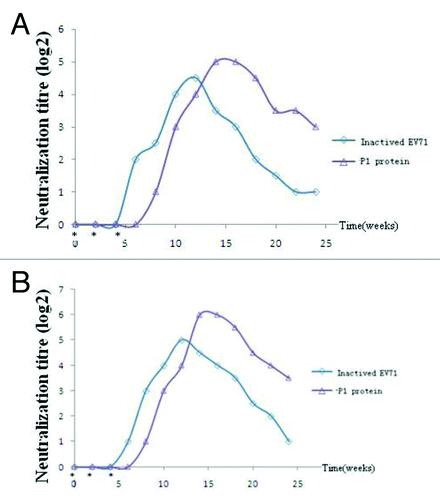
Table 1A. The protection conferred by the maternal antibodies against the lethal EV71 challenge in suckling mice. The female mice were immunized with the purified P1 protein; heat- inactivated EV71 at weeks 2,4,6 and allowed to conceive after the 3rd injections. The neonatal mice were born and then challenged i.p. with 10-50000 times LD50 dosage of A(BrCr ) or C(C4) subtype EV71 when one day old. The protection conferred by the maternal antibodies against the EV71 A(BrCr) subtype lethal EV71 challenge
Table 1B The protection conferred by the maternal antibodies against the EV71 C(C4) subtype lethal EV71 challenge
Table 2A. The protection conferred by antisera against lethal EV71 challenge in suckling mice. The sera were collected from rabbits (2 μg P1 group and heat-inactivated group) respectly. 100 uL of serum with top titer could neutralize the 10 LD50 virus base on the LD50 and neutralize ability assay results. The heat-inactivated (56oC, 30 min) rabbits sera and live EV71 virus(10 LD50,50 LD50) were incubated at 37ºC for 1 hour and the virus-sera mixture was injected intraperitoneally (i.p.) into the neonatal BALB/c mice. Mice were observed daily for mortality until 4 weeks after infection. The protection conferred by 100 ul antisera against the 10 LD50 live A and C subtype EV71 virus.
Table 2B. The protection conferred by 100 ul antisera against the 50 LD50 live A and C subtype EV71 virus
Figure 4. Proliferation of splenocytes derived from immunized mice. Spleen lymphocutes from each group (P1 protein, heat-inactivate EV71 or PBS injected group) were isolated at 2 wk after the last immunization. The proliferation of lymphocytes was detected after stimulation with P1 protein, heat-inactivated EV71, PBS or Con A respectly.
